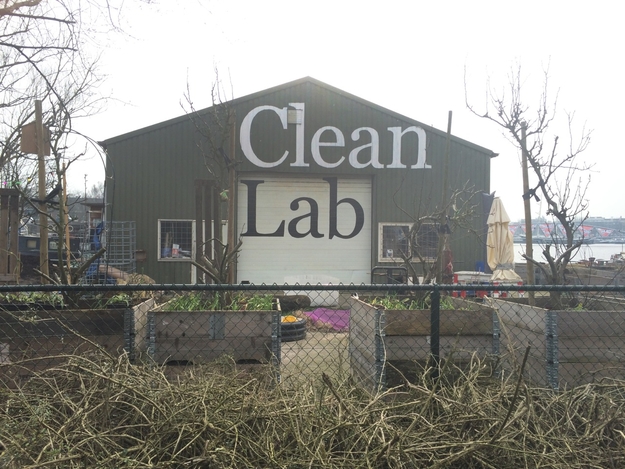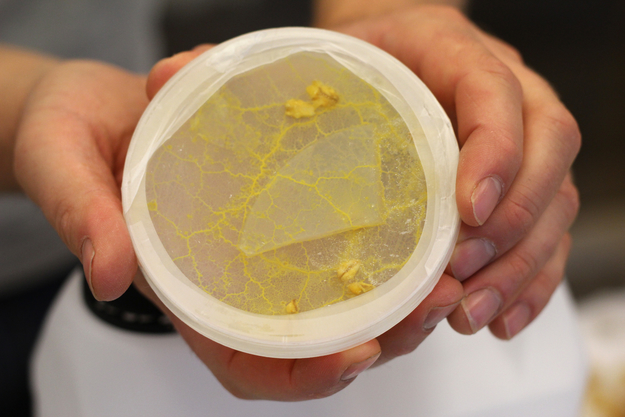The workshop
What makes the slime-mold exceptional is its unique growth process: it is able to locate the smartest routes between food sources and spreads out accordingly. Researchers have not yet answered the intriguing question: how does it find the fastest paths without a brain to process the information? It’s amazing how much we still have to learn from slippery, one-celled beings like these, which tend to be misjudged as simple and remain unnoticed.
We decided to experience and apply the slime-mold’s mysterious cognitive abilities. By placing the slime-mold’s favorite food (oat flakes) on those locations we wanted it to connect on an Amsterdam agar-map, we intended to let it find the ideal routes between them. In order to prevent other organisms from interrupting the slime-mold’s growth process, it was necessary to work in a sterilized environment. We were therefore asked to put on those white, long-sleeved hooded suits used in movies when quarantine is declared due to the spread of some horrendous disease. These were complemented, of course, with corresponding masks, gloves and even plastic shoe-covers. Pedestrians walking by on the Vijzelstraat were very intrigued and highly amused by the sight, regularly stopping to look inside. Meanwhile, we got to play in our new attire, feeling very professional, with different surfaces and food sources, lab gadgets etc., and made our own, intelligent, map of cultural Amsterdam.
The results
Infographics and data visualizations are changing the way people find and experience stories. They help communicate complex ideas in a clear, compact and beautiful way, taking data and presenting it in visual shorthand. Normally the visualizations are made using software and statistics. Of course a living organism is more difficult to control, and the outcome can be a bit unexpected, but this workshop was a good first step in learning how to direct the organism. This time we used a vinyl map of Amsterdam and stuck it to the bottom of some petri-dishes. Next time we'll look into using a 3-D printer and 'print' the agar in the shape of the map of Amsterdam to make the visualizations even more accurate. We are now investigating this and working together with Fablab (Waag Society).
After about two weeks, we gathered to examine the results of the experiment carried out during the workshop. It turns out that even with the white suits, gloves, masks and other aseptic measures we took to keep organisms from growing and competing with our slime-mold, some bacteria slipped through at some point in the process, altering its development. However, this allowed us to observe something very interesting: slime-mold growing on black fungus... who would've thought?
Luckily we prepared two maps: although one of them was contaminated and is now a mosaic of textures and colors, the other one remained bacteria-free, leaving the slime-mold to grow as it pleased, finding the shortest routes from oat flake to oat flake. A time-lapse was made recording the development of the slime-mold; it is amazing to watch the way the organism grows and explores, expanding in wave-like, yellow pulses that branch out in search for food. This time-lapse is now exhibited, together with the agar-maps, at Mediamatic Bank as part of the Paddestoelen Paradijs exhibition.
However aesthetically pleasing the result of the experiment was, we realized that the paths marked by the slime-mold do not have a practical application. The problem is that streets were not reflected on the agar-map, so the intelligent route identified by the slime-mold would involve jumping over buildings and swimming through canals to get from one cultural hub to another; as I said, not very practical. If we were to repeat the experiment, and in order to create a truly intelligent map, it would be necessary to have the agar reproduce streets and buildings, canals and other obstacles that might be found between the different targeted locations. One way to do this would be by building a plastic labyrinth, resembling Amsterdam's layout, that we pour the agar onto. This way the slime-mold would be faced with the same difficulties when trying to get around the city, and the path it identified would have more practical applications.
The slime-mold workshop offered us an initial glimpse into the world of microorganisms. It unveiled the tumultuous micro-activity that is constantly taking place around us, so often ignored, and brought awareness to its countless potentials.


